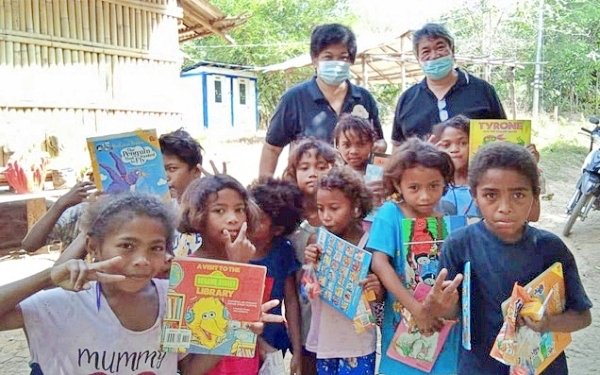I was in my hometown of Castillejos, Zambales (Philippines) last year when COVID-19 struck. City borders were closed and travel was restricted.
I am a professor, administrator and researcher at the University of Asia and the Pacific. After 24 years, I went on sabbatical leave. What was I supposed to do now, stuck on the foothills of the Zambales mountains? Some of my family and friends liked going for hikes in the mountains. But that didn't really attract me. There were books to read and countless webinars to join. But did I really want to spend my time immersed in print and in digital platforms?
Family outreach to the Aetas
It was then that my husband, Lambert, and I set out to do something we had never done before: a family social responsibility project for the benefit of the Aetas.
The Aetas are the earliest known inhabitants of the Philippines. These indigenous people are now mostly found in the Zambales mountains, where their ancestors have been living for thousands of years. They are a nomadic people, dark-skinned and curly-haired; small in stature and skilled in hunting and jungle survival.
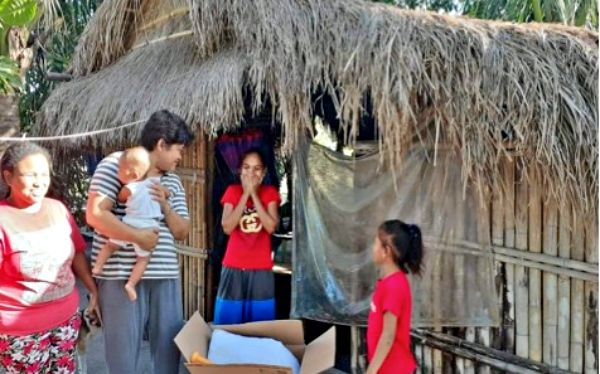
The Aetas live in simple nipa shelters: four walls made of bamboo and kogon grass roofing or sometimes GI (galvinized iron) sheet. The flooring is the earth. An elevated bamboo platform serves as bed for the family to sleep at night. There are no private toilets and no plumbing. There is electricity only in some sectors.
Lambert and I started asking our friends in Manila for all sorts of basic goods, which the Aetas could use. My friends Leni and Medoy were the first to respond. Soon other colleagues and acquaintances from Opus Dei, from the University of Asia and the Pacific, from abroad, relatives, and many others gave donations in cash and kind. We gathered quite a load of goods when we began in September 2020.
Our neighbors in Castillejos learned about what our family was doing and gave cash donations, which we used to buy rice, cooking oil, sugar, groceries, laundry soap, toiletries and nail cutters.
The destination of these goods was Kanaynayan, an area in the nearby mountains inhabited by Aetas. There are around 500 families here living in four Sitios (localities): Nilasin, Balenting, Papaya, and Lomboy. These places are nowhere to be found in Google Maps.
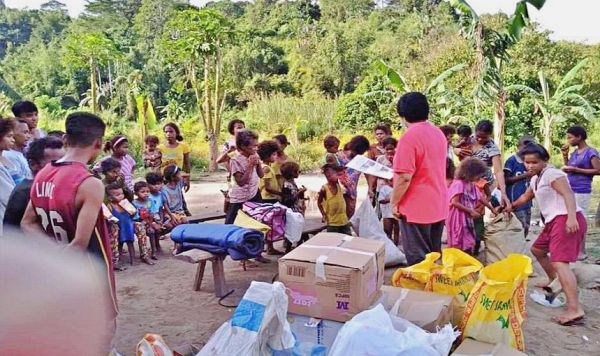
There are more children than adults in these communities. There are many young mothers and fathers. They have no formal education or religious instruction.
We packed the goods accordingly, giving priority to the “poorest of the poor” in these different localities. We distributed the goods in the Sitios. The selected poor families gathered with us in a common shaded area.
Sitio Nilasin Study Center
Teacher Jean Buted who taught Alternative Learning System (ALS) modules in Sitio Lomboy came to me one day asking for help to install a GI sheet roof on their nipa hut classroom. They had banana leaves as roofing.
Jean needed a functional place to hold the Department of Education (DepEd) ALS modular classes and other educational activities for the children. The classroom was run down and it was best to put up a new structure. More than a classroom, I thought of a multi-purpose study center.
My niece Erin, a chemistry student residing in the US, has a deep social conscience. She wanted to raise funds for school children in Makati. Since schools were closed and children were confined to their homes due to the pandemic, I suggested to Erin to help build instead a study center for the Aetas. She readily agreed and provided the funding.
An elderly Aeta leader, Manuel Romualdo, owns a property in Sitio Nilasin. Many Aeta families reside in this Sitio, which is adjacent to Sitio Lomboy. He agreed to have the Study Center built on his property.
On September 15, Lambert and I did mountain climbing led by Teacher Jean and her colleagues. We crossed two rivers and climbed the muddy, slippery, rocky slopes to mark the spot where we would construct the 4x5-meter study center. To allow for expansion, I designed the door on one end so that, when needed, the place can open up to an overflow crowd of learners outside.
To involve the Aetas and make them feel ownership, we asked them to provide bamboo for the walls and labor to construct the study center. The barangay captain lent the Elf truck to bring construction materials up the mountain to a certain point. From there the Aetas carried them to the site.
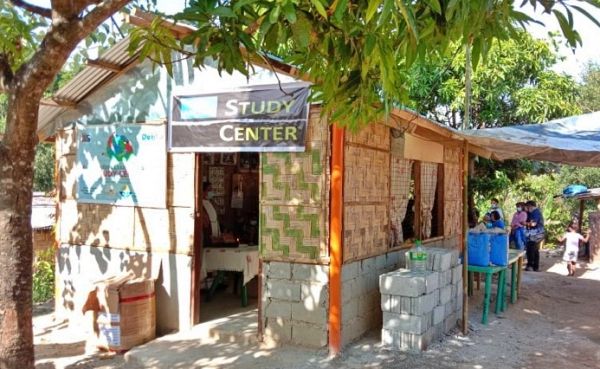
On October 29, the dream became a reality! No more classroom with banana leaf roofing. Now, they have a brand new Study Center with a GI sheet roof, nice walls, and concrete flooring.
My friend, Maria Fe, donated 10 monoblock tables and 28 chairs. Erin sent us microscope replicas, anatomy and chemistry posters, experiment kits, beakers, math boards, etc.
We furnished the place with books for all ages, learning materials, blackboard, bulletin board, crayons and other educational items that we gathered from friends. We had a beautiful experience with the kids. One day we decided to give a book to each child, and it was moving to see how he or she would hug it as if it were a bar of gold!
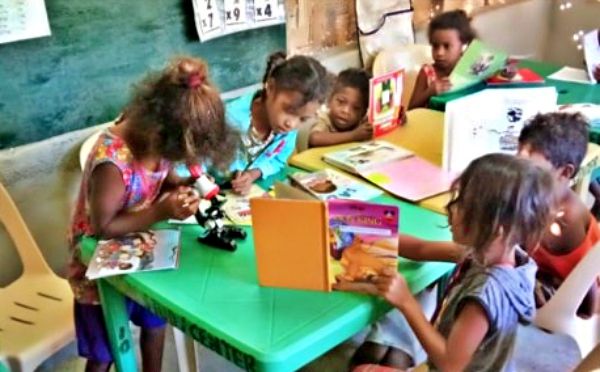
We installed electricity and brought in a television set donated by Medoy. Now they can watch TV shows such as DepEd learning shows, news, “teleseryes” and even Holy Mass. It is their community center and they committed to take care of it. A custodian was elected.
Sitio Nilasin Study Center was built by people from all over, beyond borders.
Continuing social development
The collection and distribution of essential goods for the Aetas is never-ending. The Study Center serves as our base to deliver goods to the families residing higher in the mountains.
I gave Marie, our custodian, a smartphone so we can communicate and coordinate the activities held there. It is also used as emergency phone by the residents.
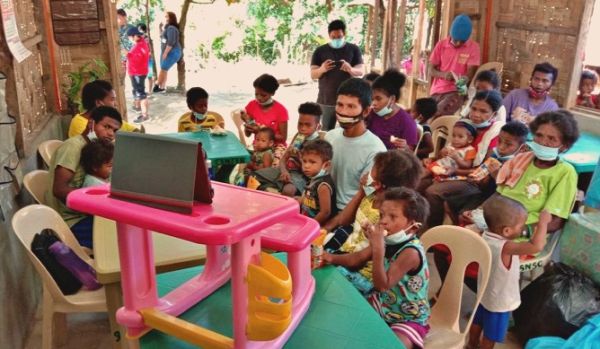
Vyera, our daughter who works as a nurse in Bedford (UK) made hygiene videos on proper washing of hands, brushing of teeth, safety protocols for COVID, etc. She sent them to me. Whenever I visit Sitio Nilasin, I show these to the residents through my digital tablet.
Then it dawned on me that God has his plans for these marginalized people. I thought of inviting our parish priest, Fr. Joel Huerto, to celebrate the first ever Catholic Mass in the Castillejos mountains for the Aetas. This happened on March 8, 2021 at our Sitio Nilasin Study Center. It was a joyous and meaningful day for all! 500 years after the arrival of Christianity in the Philippines, the Catholic presence has begun in this “far away place” not chartered in Google Maps.
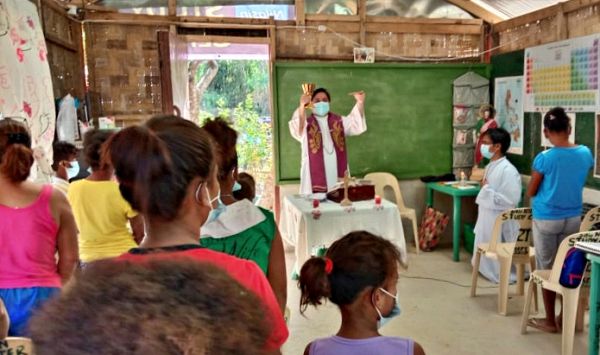
In the Ilocano dialect (northern Philippines) “Sitio Nilasin" means “Separated Site.” That may be true now. My hope is that little by little, rather than SEPARATED, the word will be INCLUDED. They will be more connected to the world and to the faith.
More community needs identified
Other things needed to be done. Sitio Nilasin sourced its fresh water from a mountain spring. Lambert went up with some Aeta leaders to inspect the spring, which is about 500 meters from the Study Center. It was pitiful to see how water was made to flow from the spring to a 4x5 ft. cemented basin on the ground, with the mud and dirt from the mountain. Murky water was channeled to the houses through a network of small garden hoses.
Thanks to You Tube, I found the most appropriate water system for a community in the mountains: sealed drums laid side by side. A 500m hose attached directly to the mountain spring will bring water down to the drums located close to the houses. Through Erin, we secured the funds.
We had to hurdle misunderstandings in the community on this project. Some attempted to stop it. Someone blocked the mountain spring so that we could not connect the main hose. Some families requested a drum and a hose for their exclusive use. We could not address everybody’s issues, but we were grateful that the blessings outnumbered the challenges. On March 12 the water system in Sitio Nilasin was completed as planned.

We taught the residents how to maintain it and keep it clean. We instructed them to grow plants around the elevated drums to prevent muddy surroundings.
There are other pressing needs, such as young fathers and mothers who barely have work skills or livelihood options. To address this, we will be conducting carpentry training and have requested friends to donate used tools.
For the women who sell their raw crops in the market, we will put up a cooking space and bring skilled people to teach them food processing, to add to their products for sale.
For the children, all sorts of learning materials will be of use. We can invite more teachers to assist them in answering their DepEd ALS modules. Nurses can come to teach good health practices. We need donors for regular food supply, as this is a basic need of families with many children.
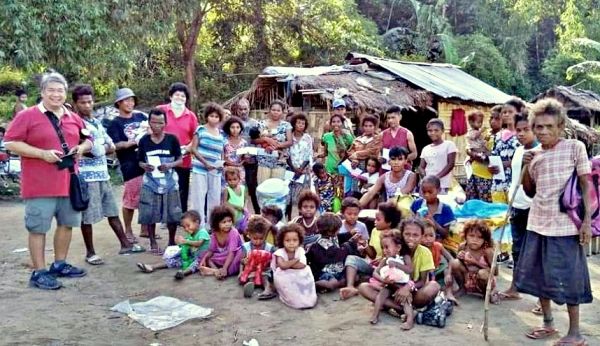
Postscript
It was during this time of pandemic, 2020-2021, when God gave us this opportunity to be at the service of the "poorest of the poor." We were able to connect with many people who were generous with their time and resources to support our efforts. It was during this time that crossing rivers and climbing mountains became for me a meaningful experience.
